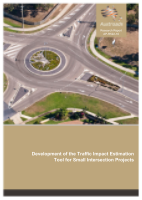Economics and Financing

- Publication no: AP-R522-16
- ISBN: 978-1-925451-28-3
- Published: 22 August 2016
- PDF (free) Download
This report describes the development of an economic evaluation tool for small intersection projects (including signed intersections, roundabouts and signalised intersections) that can be used by practitioners working with basic traffic data to estimate road user cost impacts, primarily delay and fuel costs, as well as crash costs.
The Small Intersection Evaluation (SIE) Tool does not aim to replicate sophisticated intersection analysis software or the packages developed by various jurisdictions to undertake detailed analysis of large intersection projects. Rather, the objective is to facilitate the economic evaluation of a number of small intersection projects which could provide an indication of the most promising projects which can then be subject to further detailed analysis thereafter.
- Summary
- 1. Introduction
- 1.1. Background
- 1.2. Objective of this Project
- 1.3. Scope of the Report
- 2. Review of Material and Approaches
- 3. Design of the Small Intersection Evaluation (SIE) Tool
- 3.1. Options for the SIE Tool Design
- 3.1.1. Key Attributes of the SIE Tool
- 3.2. Overview of SIE Tool Design
- 3.3. Traffic Data Inputs
- 3.3.1. Traffic Data Categories
- 3.3.2. Treatment Life and Analysis Period
- 3.4. Base and Project Case Inputs
- 3.4.1. Inputs for Base and Project Case
- 3.4.2. Agency Costs (Capital and Maintenance Costs)
- 3.5. Intersection Safety Treatments
- 3.5.1. Inputs for Intersection Safety Treatments
- 4. Calculation of Impacts and Presentation of Results
- 4.1. Methodology for Calculation of Traffic Impacts
- 4.2. Calculation of Crash Costs
- 4.3. Crash Rates
- 4.3.1. Published National Crash Rates
- 4.3.2. Crash Rates Used in the VicRoads Intersection Evaluation Tool (ISEVAL)
- 4.3.3. Estimated Crash Rates for Most Vulnerable Intersections
- 4.3.4. Crash Rates Adopted as Default Values in SIE Tool
- 4.3.5. Estimated Intersection Crash Costs
- 4.3.6. Crash Modification Factors
- 4.4. Results of Analysis
- 4.4.1. Annual Impacts
- 4.5. Updating of the SIE Tool
- 5. Checking, Calibration and Testing of the SIE Tool
- 5.1. Issues Identified by ARRB
- 5.2. Comparison with Existing Sources
- 5.2.1. Comparison with John Piper Ltd Black Spot Evaluation for BITRE
- 5.2.2. Case Study Comparison of SIE Tool: Adelaide Road – Wellington Road (Black Spot Reference No. S00028)
- 5.2.3. Case Study Comparison of SIE Tool: Eastern Parade – Bedford Street (Black Spot Reference No. S00004)
- 5.2.4. Findings
- 5.3. Comparison with Available Jurisdiction Case Studies
- 5.4. User Guide
- 5.5. Release of the SIE Tool for Testing by Jurisdictions
- 5.5.1. Feedback from Practitioners and Changes to the SIE Tool
- 5.5.2. Issues Relating to Traffic Impact Estimation
- 5.6. Comparison of Traffic Impacts Arising from SIE Tool with Those from SIDRA
- 6. Conclusions
- References
- Appendix A Detailed Review of Relevant Material and Approaches
- A.1 John Piper Traffic (2008)
- A.1.1 Key Assumptions
- A.1.2 Results Framework
- A.1.3 Key Findings of the aaSIDRA Analysis
- A.2 Evaluation of the National Black Spot Program (BITRE 2012)
- A.2.1 Omission of Traffic Impacts from Appraisal of Black Spot Treatments
- A.2.2 Results of the BITRE Analysis
- A.2.3 Key Findings of the BITRE Analysis of Black Spot Treatments
- A.3 Operating Cost, Fuel Consumption and Emission Models in aaSIDRA and aaMOTION (Akçelik & Besley 2003)
- A.3.1 Key Equations/Models in aaSIDRA
- Fuel consumption
- Emissions function
- Operating cost function
- A.4 Issues in Performance Assessment of Sign-controlled Intersections (Akçelik 2012)
- A.5 Emissions Impacts of Traffic Congestion Management Techniques (Rouphail 2008)
- A.6 Guidelines for Selecting Techniques for the Modelling of Network Operations (Austroads 2010a)
- A.7 Austroads Guide to Traffic Management (Austroads 2013)
- A.8 ISEVAL Intersection Evaluation Model (VicRoads 2012)
- A.8.1 Travel Distributions in ISEVAL
- A.9 Rapid Estimation Tool for Traffic Benefits at Intersections CARP (TMR 2013)
- A.9.1 CBA6 Intersection Analysis
- A.9.2 Rapid Evaluation Tool (CARP)
- A.10 Austroads Guide to Project Evaluation Part 8: Examples, Example 5: Black Spot Evaluation (2006)
- A.11 Highway Capacity Manual 2010
- Appendix B Detailed Methodology Used to Estimate Traffic Impacts
- B.1 Signed Intersection
- B.1.1 Rationale
- B.1.2 Method Applied to Calculation
- Numbering of approaches
- Traffic volumes per approach
- Conversion of traffic volumes to passenger car units (PCUs) per approach
- Traffic volumes (PCUs) on major road
- Traffic volumes (PCUs) on minor road
- Capacity of approaches
- Volume capacity (VC) ratio
- Cost calculation
- Delays to traffic on major road (approaches 1 and 3)
- Delays to through traffic by right turn traffic
- B.2 Roundabouts
- B.2.1 Rationale
- B.2.2 Method for Calculating Roundabout Delay
- Treating the intersection as a give-way
- Treating the intersection as a merge
- B.2.3 Method Applied to Calculation
- Number of approaches
- Major and minor approaches
- Calculation of VC and costs
- B.3 Signalised Intersections
- B.3.1 Rationale
- B.3.2 Method Applicable to Calculations
- Right turn lane (RTL) factor
- Volume and capacity calculations
- VC calculation
- Correction for share of green time per cycle
- Correction factor for more or less share of the available green time
- Cost calculation
- Appendix C Crash Modification Factors
- Appendix D Coefficients for Estimation of Delay, Fuel Consumption, Other Rue and Emissions
